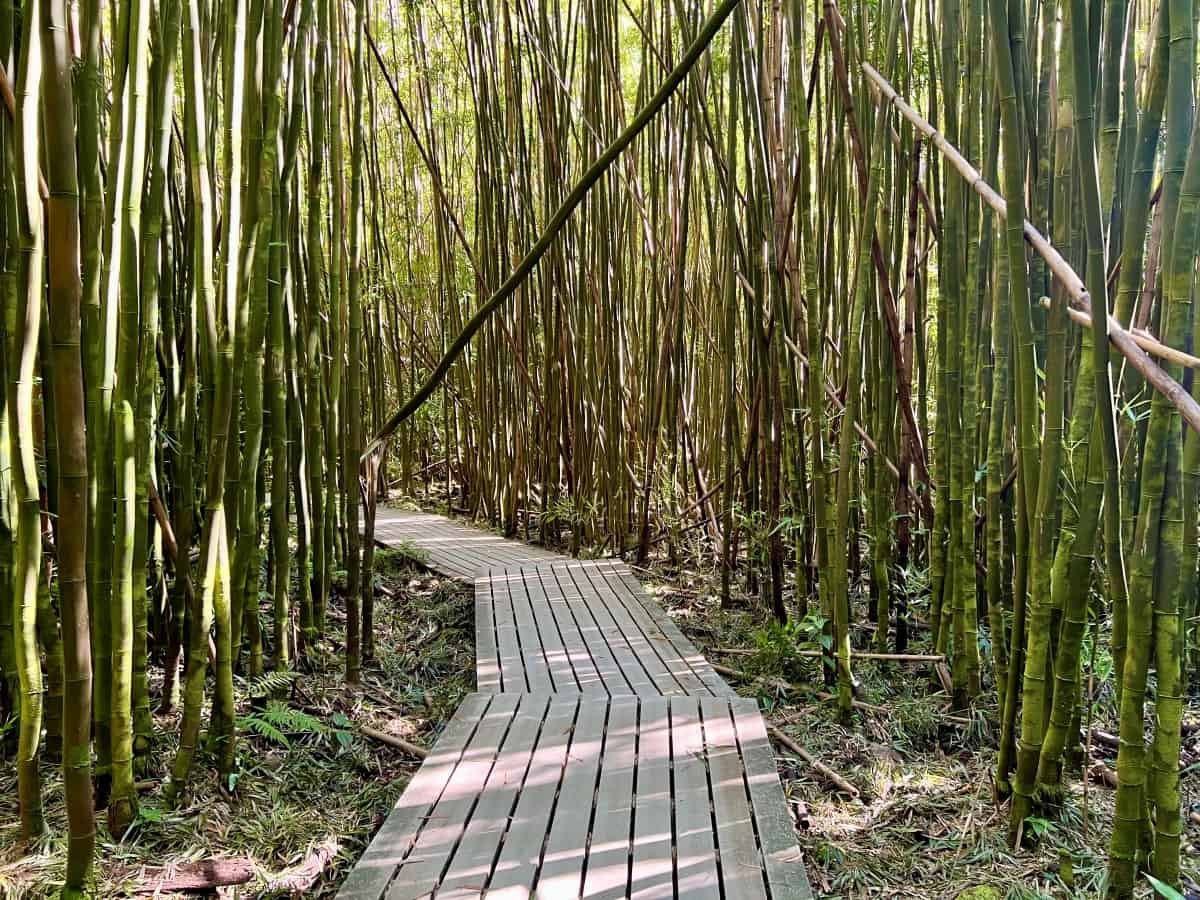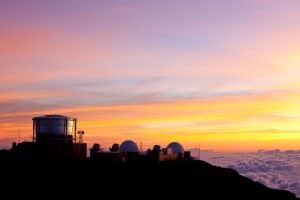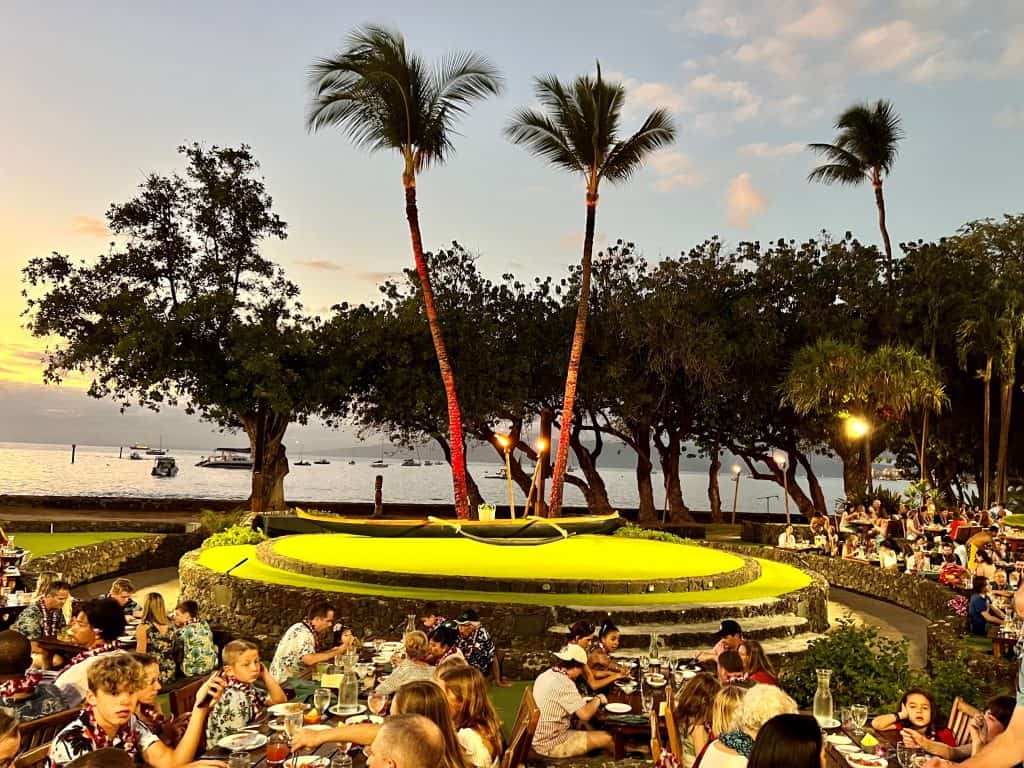My Expereince Hiking the Unique Pipiwai Trail in Maui
The Pipiwai Trail in Haleakala National Park is one of my favorite hikes on Maui. I hiked it with my family as part of our 2-day Road to Hana itinerary, and it ended up being one of our most memorable experiences on the island.
With just a little effort, this hike rewards you with incredible sights – a huge banyan tree, a peaceful bamboo forest, and the stunning Waimoku Falls at the end.
Because the trail is in the remote Kipahulu District near the end of the long and winding Road to Hana, I spent quite a bit of time planning the logistics before our visit. In this guide, I am sharing everything you need to know about hiking the Pipiwai Trail to Waimoku Falls, along with tips from our experience.
Pipiwai Trail: Quick Overview
Below are some quick facts about hiking the Pipiwai Trail in Maui:
- Hike stats: This is a 4-mile out-and-back trail with an elevation gain of around 900 feet. It is considered a moderate hike and usually takes about 3 hours to complete.
- Where is it? The trail is in the Kipahulu District of Haleakala National Park, near the end of the long Road to Hana drive on the east side of Maui. The trailhead starts near the Kipahulu Visitor Center.
- Parking and Fee: There is a parking lot at the trailhead. The entrance fee for Haleakala National Park is $30 per vehicle and is valid for 3 consecutive days.
- Trail type: Dirt path with uneven terrain, stone steps, and boardwalk sections through the bamboo forest.
- Family and accessibility: The hike is family-friendly but not suitable for strollers or wheelchairs. Dogs are not allowed on this trail.
- Best features of the Pipiwai hike: I loved walking on the boardwalk part of the trail through a dense bamboo forest. The banyan tree was huge, there were several waterfalls along the way, and the towering Waimoku Falls at the end was stunning.
Let’s get into the details about the hike and my experience exploring this scenic waterfall trail through the bamboo forest in Hana.

Getting There
The Pipiwai Trail is in the Kipahulu District on the southeast side of Haleakala National Park. It’s about 12 miles past Hana, near Mile Marker 42 on the Road to Hana. The trailhead is next to the Kipahulu Visitor Center, and the parking lot is inside the national park.
Reaching the trail requires driving the entire Road to Hana and then continuing past Hana town. It takes about 3 to 4 hours one-way from South or West Maui without stops, and about 30 minutes from Hana.
Here’s a rough idea of drive times from various places in Maui to the Pipiwai trailhead without any stops:
- Kaanapali – about 3 hours 30 minutes
- Lahaina – about 3 hours 15 minutes
- Kihei – about 3 hours
- Wailea – about 3 hours
- Paia – about 2 hours 30 minutes
- Hana – about 30 minutes
You’ll need a rental car to reach the trailhead, as most Road to Hana tours don’t include this hike. The drive is beautiful but challenging, with narrow curves and one-lane bridges. Even if you plan to go straight through, you’ll likely want to make a few scenic stops along the way.
Tip: I recommend getting the Gypsy Road to Hana Audio tour which gives you information about the upcoming stops on the Road to Hana and anywhere else in Maui as well. We used it and it was very helpful!
If you’re starting from West or South Maui, plan to leave between 5:30 and 6 in the morning to reach the Kipahulu entrance around 9 AM, when it opens. Many people spend too much time at the earlier Road to Hana stops and end up skipping the hike entirely. I recommend doing the Pipiwai Trail first and exploring the stops on your way back.
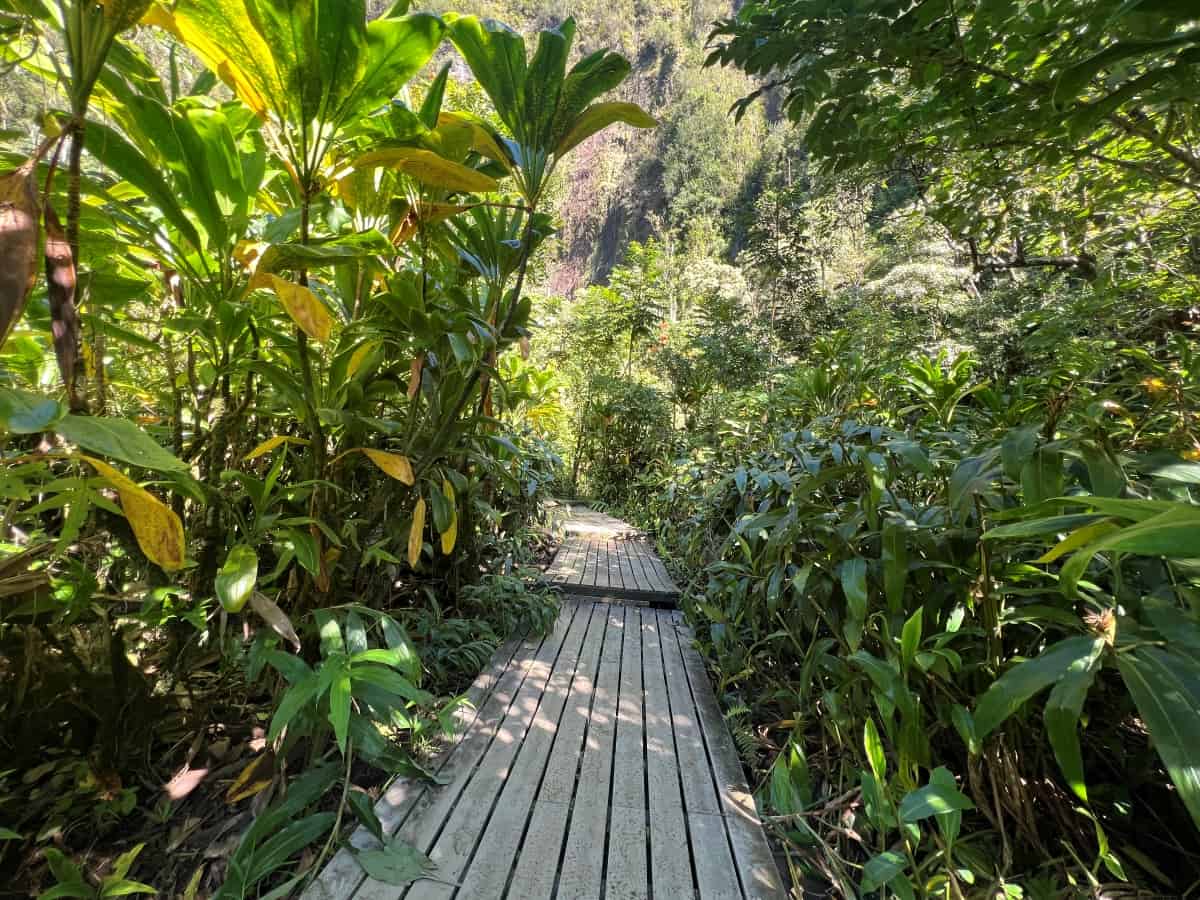
Staying Overnight in Hana
One of the best ways to experience the trail is to stay overnight in Hana. This is what we did, and it made the experience much more relaxed.
➡️ We stayed at the Hana Kai Maui in a spacious apartment with a lanai overlooking the ocean. I highly recommend it! The Hyatt Hana Maui was sold out for our dates, which would have been a great place to stay as well.
From Hana, it’s only a 30-minute drive to the Kipahulu entrance. Hiking early in the morning was peaceful and much more enjoyable than starting after a long, winding drive. Afterward, we had the rest of the day to visit the other Road to Hana stops at a slower pace.
Back Road to Hana
There’s another route to reach the Kipahulu District from the other side of the island on Piilani Highway, also known as the Back Road to Hana. I don’t recommend this route unless you’re familiar with local driving conditions.
Parts of the road are unpaved and very narrow, making it difficult for two cars to pass. It’s best left to locals or guided tours that are familiar with the road.
Parking, Hours, and Entrance Fee
Parking is available at the Kipahulu Visitor Center inside Haleakala National Park. The Pipiwai Trailhead is a short walk from the lot, just across the Hana Highway. The trail is well-marked and easy to find.
The park is open daily from 9 AM to 5 PM. Cars often line up before opening, so it helps to arrive early to beat the crowds. We reached around 9:10 and found the lot already filling up.
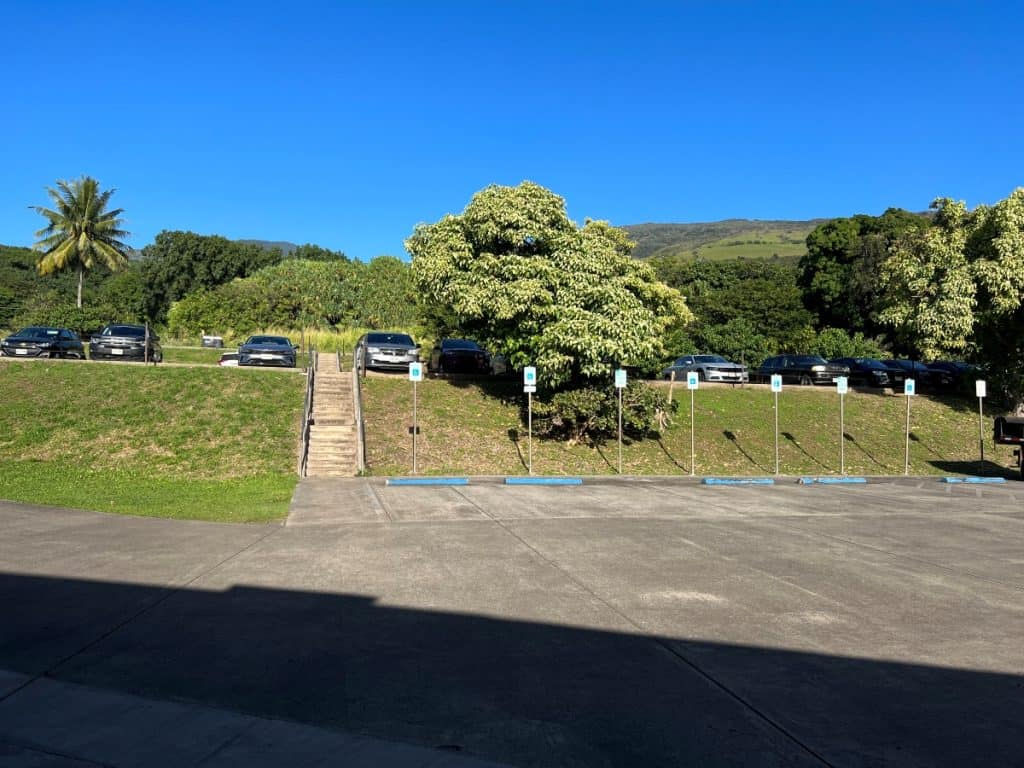
The entrance fee for Haleakala National Park is $ 30 per vehicle or $ 25 per motorcycle. The pass is valid for three consecutive days and also covers entry to the Haleakala Summit, which we used later that weekend.
No advance reservations are needed to hike the Pipiwai Trail or the nearby Oheo Gulch Trail. We just showed up and paid the park fee at the entrance gate.
Hiking the Pipiwai Trail
Pipiwai hike is one of the most beautiful waterfall hikes in Hawaii and a must-do in any Maui itinerary. The hike is only 2 miles one way and has so many interesting and unique features to explore along the way.
Where else will you get to see more than a hundred-year-old majestic Banyan tree, walk through a dense bamboo forest, and see some towering waterfalls? Only on the Pipiwai Trail hike!
We started our hike around 9:15 AM and were among the first on the trail. While going up, we had the trail to ourselves plenty of times. We could hear the sounds of the forest, birds, waterfalls, and bamboo plants. It was magical and soothing!

On the way back, a lot of people were on the trail, and the forest sounds were drowned out by all the foot traffic and people talking.
Luckily, it hadn’t rained the week we were in Maui, so the Pipiwai Trail was very dry, which was awesome. If it has been raining recently, the trail can be quite muddy and slippery.
Hiking boots are needed on the Pipiwai Trail due to the uneven rocky terrain. While coming back down, we saw several people, even kids, going up the trail in flip-flops, and we felt that was a bad choice of footwear for this trail!
The entire hike had shaded areas on and off, which was great, and we did not feel too hot during the hike. I think the early morning time helped, too, with the heat.
Start of the hike
The Pipiwai Trail hike starts near the Kipahulu Visitor Center at Pipiwai Trailhead, just past the parking lot.
At the start of the trail, you will see a signboard that points to the left for the Pipiwai Trail. The Right trail takes you to the Pools of Oheo. Take the left trail and climb up the short path to reach the Hana Highway.

You will cross the single-lane highway here to get to the Pipiwai trail on the other side of the highway. After this, the trail path is very easy to follow.
The initial part of the trail is all uphill with a series of stone steps and sometimes even natural steps made by tree roots! The terrain keeps changing, keeping the climb interesting.

Makahiku falls
Around 0.5 miles into the trail, we reached the Makahiku Falls viewpoint.

The day we went, it was quite dry, so the falls were just a trickle. But if it has rained recently, the falls can be quite impressive.

Banyan Tree
Around 1 mile into the Pipiwai hike, we reached the majestic banyan tree. No camera can do justice to this magnificent tree or capture its vast spread.
The hanging roots from the tree have become tree trunks themselves. The tree is just so mighty and peaceful at the same time.

In the morning, we had the tree to ourselves for some time! It was a great experience to just admire the tree and feel humbled in its grand presence.
Later in our Maui trip, we saw another huge Banyan tree at the Lahaina waterfront that was equally huge!
After the Banyan tree, we crossed a bridge, and there was another set of cascading waterfalls and pools to enjoy from the bridge viewpoint.

Bamboo Forest
Around 1 mile into the trail, just shortly after the banyan tree, we entered the bamboo forest part of the hike. The walk through the bamboo forest was the best part of the hike. This hike is also referred to as the Bamboo Forest hike.

Sections of the trail through the bamboo forest are flat, with boardwalk panels to walk over. At times, the trail became rocky, alternating between boardwalks and rocky terrain.
The scenery in the bamboo forest is hard to describe in words. You have to be there to experience the magic of it! The boardwalk wound through towering bamboo on both sides, and the only sounds were the rustling leaves and the soft creaking of the stalks in the breeze, especially if you had a section to yourself.

Waimoku Falls
After crossing the bamboo forest over the boardwalks, we could finally start to see the Waimoku Falls in the distance.
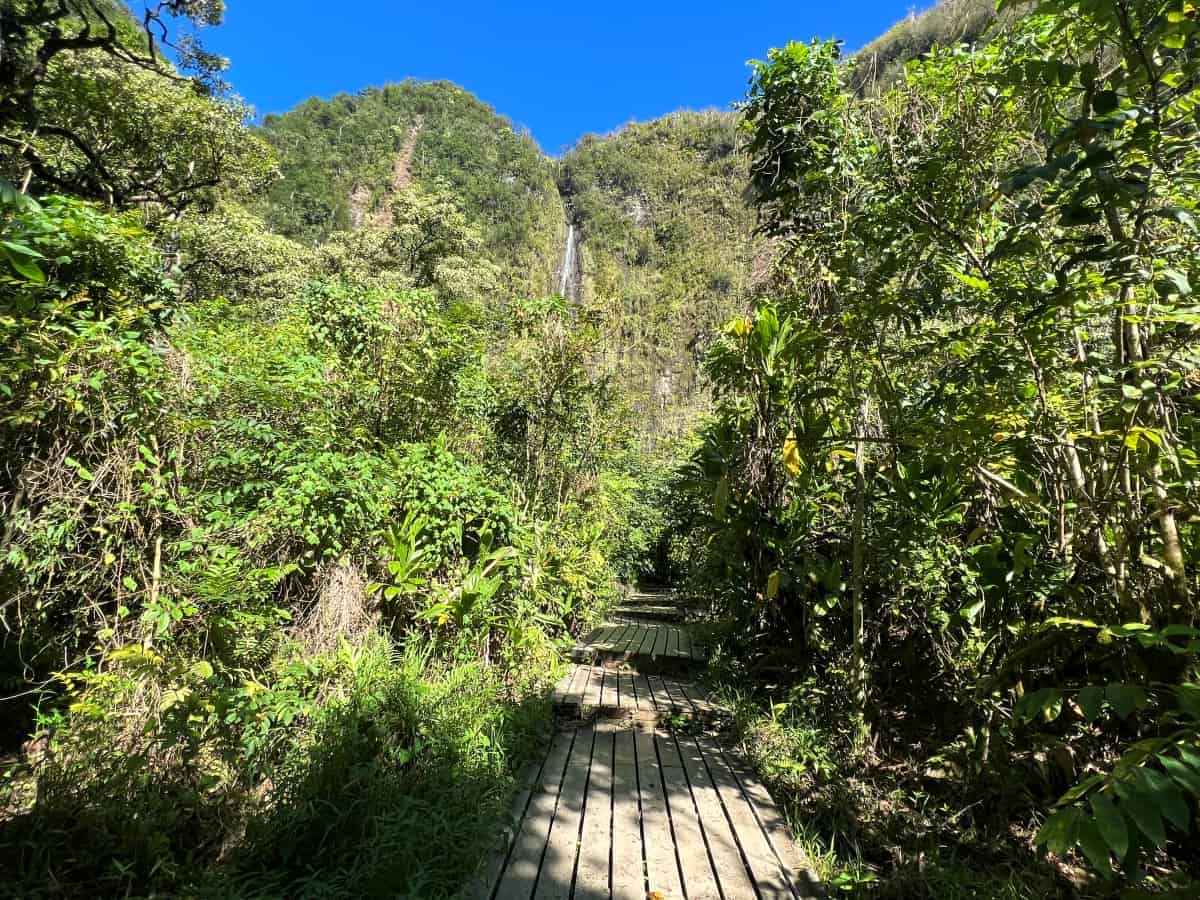
Waimoku Falls is a towering 400-foot waterfall that can be seen from far away.
You need to cross a small stream with boulders to reach closer to the falls.
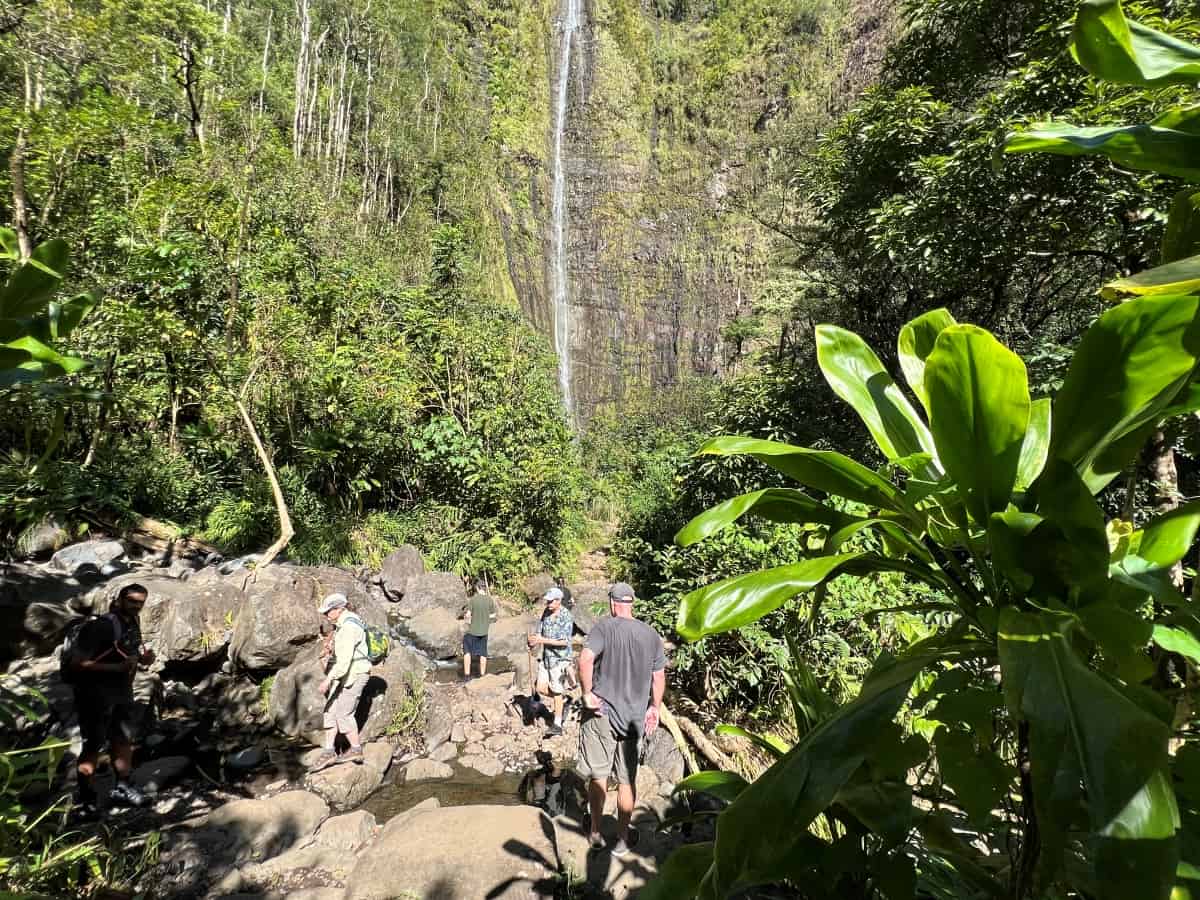
Since 2021, the National Park has posted a large sign prohibiting visitors from going to the base of the falls. We saw folks still going past the sign, but it was at their own risk.

Swimming in Waimoku Falls is not permitted due to the danger of falling rocks and debris from above, which can be fatal.
We decided to turn back and respect the rules as they are there for a reason and for our own safety.
Return hike
The return hike is going back the same way you came. Going downhill is hard on the knees, and I am glad I had my hiking sticks for support.
We spend some time just standing in the bamboo forest and listening to the sounds of the bamboo plants rustling in the wind. We also stopped again at the Banyan tree, as it was just so impressive!
Finally, we reached the Pipiwai Trailhead near the Visitor Center.
Extending the hike to see the Pools of Oheo
After reaching the starting point of the Pipiwai trail, we continued on the trail to the right of the fork to see the Pools of Oheo. The 0.5-mile loop trail is also called the Kuloa Point trail.

There were a couple of viewpoints on the trail to see the cascading Pools of Oheo and where the pools meet the ocean. The panoramic coastal views here are breathtaking!
Tips from our visit
These tips will help you make the most of your hike and your visit to the Kipahulu District of Haleakala National Park.
Start early
The best time to hike the trail is right when the park opens at 9 in the morning. Very few people make it that early, so we had the trail mostly to ourselves on the way up.
Plan for about 2 to 3 hours
It took us around 3 hours, but we took several photo stops. It takes around 2 to 3 hours total to hike the Pipiwai trail, depending on how many stops you make for photos or to admire the scenery or simply to catch your breath!

Expect a moderate workout
The Pipiwai Trail has some steep and uneven sections, along with a few stone steps, but it’s manageable for most people in good health. Hiking poles are helpful, especially if you have knee issues. They definitely helped me on my way back.
There is a national park fee
You’ll need to pay the Haleakala National Park entrance fee, which is 30 dollars per vehicle or 25 dollars per motorcycle. The entrance fee is valid for three consecutive days and also works for visiting the Haleakala Summit, which is what we did.
Pack smart
The trail is in a remote area, so it’s best to bring everything you’ll need for the day. Here’s what I recommend packing:
- Comfortable sneakers or hiking shoes – the terrain can be rocky or muddy, so skip the flip flops.
- Reusable water bottle – There is a bottle-filling station near the Kipahulu visitor center.
- Food and snacks – It’s best to carry some snacks or food to eat after the hike. We took banana bread with us!
- Mosquito repellent – we forgot ours and paid for it with itchy bites that lasted for days.
- Sunscreen, sunglasses, and a hat – parts of the trail are exposed to the sun.
- Hiking poles – If you need them for ascending/descending
- A small first aid kit just in case.

Explore more nearby
After finishing the hike, there are plenty of other stops on the Road to Hana worth exploring. You can walk the short loop to the Pools of Oheo, visit Hamoa or Koki Beach, stop for Huli Huli Chicken, or see Wailua Falls. You can also explore Hana town, visit the Hana Lava Tube, or relax at the black sand beach in Waianapanapa State Park (advance reservations required).
Stay overnight in Hana
Staying overnight in Hana is the best way to do the Pipiwai trail hike, as you can reach the trailhead in 30 minutes from Hana town. Driving from West or South Maui can take 4 hours to reach the trailhead, and there can be traffic, which can take even longer.
Below are some accommodation options in Hana:
- Hyatt Hana-Maui Resort is the best luxury accommodation in Hana, with a restaurant, spa, pool, and activities.
- Hana-Kai Resort is a mid-range oceanfront resort next to a black sand beach. This is where we stayed, and it was amazing!
- Heavenly Hana Paradise is a mid-range guest house with several studio rooms and private bathrooms. The location is serene in a tropical setting and close to food options in Hana.
- There are several vacation rentals in Hana, and you can book one suitable for your group size.
Final Takeaways
The Pipiwai Trail is truly a bucket list hike and one of the best waterfall hikes in Hawaii. It has several unique features like a massive banyan tree, a peaceful bamboo forest, and the towering 400 foot Waimoku Falls at the end.
Because the trail is at the far end of the Road to Hana, staying overnight in Hana is the most relaxed way to experience it. That’s what we did on our Maui trip, and it made our day much easier.
If you’re planning to visit as a day trip, start early from West or South Maui and drive straight to the trailhead. You can explore the Road to Hana stops on your way back.
Up next, read my Road to Hana guide to plan your route and make sure you don’t miss any of the must see stops along this unforgettable drive.
Related Posts
Check out my other posts about Maui below:

